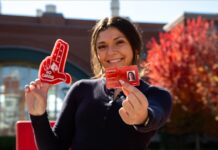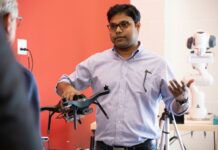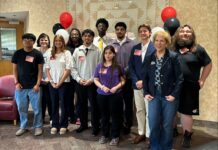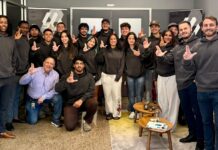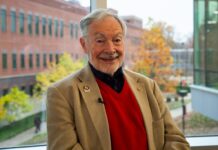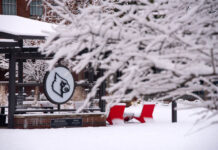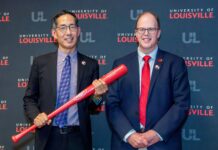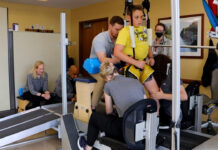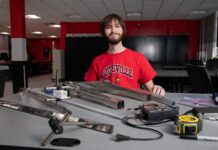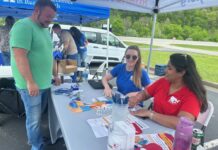They will spend their time working at medical clinics in several cities, helping physicians with general health exams and giving away eyeglasses paid for by the Shri Hari Om Charitable Foundation.
Gerome Stephens, coordinator of student leadership in Office of Civic Engagement, Leadership and Service, is accompanying the group. While in India, Stephens and the students will send UofL Today updates about their trip, their work and photos.
They will return to Louisville Dec. 23.
(Most recent blog entries posted first)
Jan. 13, 2010
Looking Back
After returning to the United States, taking one of the best showers of my life and staying mostly awake through Christmas, I am now settling in with the idea that I was in India. It seems surreal and, although it was very recent, so far away. I find that I am missing it much more than I intended to. As much as I appreciate being home and among familiar faces and places (and smells), India provided something new and different everywhere we turned. I miss hearing the rhythm of a different language and accent. I miss the energy of the busy streets and the crowded markets. Mostly I miss the camps.
Although I often wished during our trip that I knew Hindi in order to communicate with people I was interacting with, the nonverbal communication we used in substitution provided a different connection altogether. I did not need to know how to say, “Would you please sit down,” in order to invite someone to sit across from me at the table with a hand gesture. I did not need to know how to tell someone that they were okay in their own language in order to use the universal meaning of a smile and a head nod. I miss that contact of connecting by meeting eyes instead of exchanging words. Your actions become more intentional when you know someone is studying them to extract meaning.
Body language of showing gratitude is also universal. And no matter how long it took to communicate test results or directions of where to go next, hearing “thank you” or receiving a bow of a head with hands clasped together, a smile or a pat on hand made me feel that my intention had made a difference. It reassured me that my signs communicating reassurance had been received.
This is why, when people ask me, “What was your favorite part of the trip?” I do not need to hesitate before telling them it was the medical camps. I enjoyed working at the camps not because I am going to be a doctor or a nurse or pursue any other medically related occupation but because that was when I connected with people most. That was where I held hundreds of hands to test blood and exchange crayons with children. That was where I nodded my head countless times to acknowledge the group of people staring at the strangers who had entered their town.
And if people really needed to get a message across to us, they found a way. One man specifically came up to Chris and I after the first medical camp was coming to a close to talk to us. Once Sahiba came to translate his kind words we discovered that he was wishing us well because of what we did in the village. One phrase I remember specifically is, “God will give you many blessings and lift you up on his wings.” In that situation, I was glad to understand his words.
-Maria Gurren, senior, psychology major, sociology minor
Dec, 22, 2010
Nearing the end
Nearing the end of my second two-week stay in northern India, how do I feel? I feel so ambivalent. Don’t be misled, I LOVE India. I’m so happy to be here, and so sad to leave. I’m already scheming up ways to come back in my future, and voicing remorse for how any return to this country will never be the same as this amazing experience. But I know that the main thing pushing me to return whenever I can is that I know I haven’t realized the depth of what India really means.
Yesterday, at the beginning of our last medical camp I told Sahiba that I loved how the grey skyline of a dirt and urine stained slum was interrupted by a beaming white marble temple. But, upon further reflection, I wonder, why should I marvel a beautiful symbol of hope exists even here? I constantly find myself staring at women’s sarees, the sequins of which can sparkle like starlight, even in the early morning smog of Delhi. It’s true, India is beautiful, but as an outsider, how much am I distracted from corruption, violence, poverty, ect., by marble structures and 22 ct. gold?
Perhaps it’s just me. One of my personal setbacks is that I repress negative emotions- a residual effect of childhood Post-Traumatic Stress Disorder. What that means is that either I literally don’t experience things as being as bad as they are, or in my memory bad things seem to have been more bearable than they actually were. For a light example, I’ll be bouncing giddily down a dirty street, with my head held high, breathing air so polluted I’m at risk of a sinus infection, and literally think to myself, “the smell of raw sewage in the air isn’t THAT bad.”
If my goal was to be a carefree world traveler, exploring the expanses of the globe for my own personal cultivation, this defense mechanism wouldn’t be a problem. However, my main aspiration for my career and my life is to make an effectual change in societies, such as India, where gross human rights violations are so pervasive. I have no intention of joining the hoards of well-meaning, but ultimately self-centered, oblivious travelers for pleasure. But I worry; how can I be aware enough to affect anything if I can’t even recognize what’s not blatantly obvious?
This is an example of what I mean: Walking through the fairly swank shopping complex of sector 17, in the “nicest city in India,” Chandigarh, I nonchalantly wave away a child selling bootlegged sunglasses from underneath his jacket. My friends/travel partners and I are on a quest to find the Burberry scarves we found the day before. I stop abruptly outside the window of an upscale clothing store to witness a man grab a woman by her throat and hit her so heard she falls against the wall of the store. He proceeds to kick her and scream at her in Punjabi until the store clerks calmly ask him to step outside. As a few minutes passed, a crowd gathered and the offender explained himself again and again, but there was no public outrage! There was obviously no real law against beating this woman in public, only a tired, understanding explanation from the store employees that looked to me like, “Dude, you can’t beat your wife here.”
The look of shame and resignation on the woman’s face made me think that she lives this life every day. I feel sick thinking of it. I was outraged, but what could I do? I felt disgusting as my group and I eventually walked away. I watched her stand off to the side, silently waiting for this scene to be over, and I knew that she was going to leave with him.
I get a tightness in my chest as I wonder, what if I were this woman? Or one of the children who play in piles of trash on the street while school is supposed to be in session? What if I were a person who had no options? And why did I take this horrible scene to unfix my gaze from the window of Delhi Jewelers?
I was struck by how many people kept walking as my friends and I had- I’m disgusted and alarmed, but then, what could they do? There isn’t a country in the world that whole-heartedly combats violence against women, or the exploitation of the underprivileged, but in a country with infrastructure as rickety as India’s—there is no real law to turn to, I don’t know of a Center for Women and Families in Chandigarh—one is literally left exasperated, wondering, what can I do?
I’m not asking these questions out of resignation, though. I want to get to know India. I’m praying (for myself and others) to have the foresight, the wisdom, and the inside advice to learn what it is that I can do. And I’m hoping for the focus to be able to recognize the whole of reality, whether it’s beautiful or disgusting, whether It’s blatantly visible or not.
-Clara Young, senior, psych major with minors in gender studies, political science, and french
Dec. 20, 2010
Midway
We’ve now passed the midway point of our trip, and words cannot describe what our group has experienced over the past week. It all began when we landed in the newly renovated, majestic Indra Gandhi Airport in New Delhi, India. As we walked the carpeted halls, and chandelier-filled terminals, most called me a liar, saying that my description of India was far from accurate. It rendered our catch phrase from last year’s trip, “We’re definitely not in America anymore,” useless. There seemed to be little difference between the clean, green, streets of The United States, and the crystal clean corridors of what has become somewhat of an Indian landmark. It took little time, however, to see the discrepancy between those who have, and those who do not, in the paradigm that is: the world’s largest democracy. Immediately upon leaving the confines of the airport, we were quickly reminded that we were in a third world country, where poverty, corruption, and pollution run rampant. We smelled, breathed, and witnessed the air that caused so many of us to catch a cough. During the drive to the bed and breakfast, it was impossible for our eyes to avoid the child-filled streets, poverty-stricken slums, and mom-and-pop street vendors that decorate the Delhi roadside.
It only took us a day, however, to once again realize the true beauty that India radiates. As we approached the white marble of the Taj Mahal, we forgot about the streets that we had just braved, to enter the fortress that secures the mausoleum. We forgot about the countless children who begged us not for money, but for business. Their next meal depended on whether or not we would buy a small trinket or a key chain from their cart. We didn’t think about that, however. Our perception was completely clouded by the wonder of the world that stood before us, perfectly symmetrical, perfectly glowing, and perfectly mesmerizing. As we walked back to the car, however, I couldn’t stop thinking about the paradigm that my motherland has become. One of the most beautiful images in the world, and definitely the most beautiful that I had ever seen, was amidst some of the poorest, dirtiest, and busiest streets in the world.
This paradox has become the theme of this entire trip. A nation with some of the world’s richest people, is filled with some of the world’s poorest. A nation with some of the world’s most awe-inspiring landmarks, is filled with some of the world’s most polluted air. A nation with one of the strongest cultures in the world, is filled with children begging for their next meal. We’re in a nation where one moment we can provide free health care to some of the world’s neediest, and the next we can be eating one of the fanciest meals we’ve ever had, at one of the fanciest restaurants we’ve ever been to. It is this discrepancy, and this very obvious need that continually pushes me each year to hopefully provide the catalyst needed to ensure that this trip, this program, and this project continue to grow, and continue to fulfill the mission of giving students unforgettable experiences, while giving them an opportunity to truly indulge themselves in the service of others.
– Deep Aggarwal, economics with finance and biology minors, junior
The Golden City
Amritsar: also known as the “holy city” and the “golden city.” It was hard to truly understand why the city of Amritsar is so well-known and well-respected until the very end of the day today. We started our journey towards this city at 9 am. After over six hours of a crammed, bumpy, and tiresome van ride, we saw a city that disappointed us on our first impression, but marveled us on our second impression. The air in Amritsar is so smog-filled and polluted that some of us started coughing the minute our windows rolled down. There are more people walking on the roads of Amritsar than there are cars. There are small shops all over the city selling everything from groceries to expensive saris (typical Indian wear). Aesthetically speaking, the city of Amritsar doesn’t impress. However, I knew that there was more that the city would offer. We visited two main tourist attractions today: the “Waga Border” between Pakistan and India, and the Golden Temple.
When I first heard that we would visit the India/Pakistan border, I was excited but didn’t really expect anything fancy. When we reached the area, we saw massive crowds of Indians running towards the border. At first we didn’t understand why people were sprinting towards the border, but soon realized that it was because there is a parade every evening right at sunset. Although it was hard for me to see the parade from my vicinity, I was able to make out the lowering of the Indian and Pakistani flags at both ends of the border at the same exact time; at one point the two flags actually met each other and represented a peace treaty between the two countries that are also known to be “frienemies.” It was astonishing to see Indians yell and chant phrases of Indian pride at this location. It was also a unique experience to see “no man’s land” and the gate that led to Pakistan.
The Golden Temple, home of Sikhism, was unbelievably breath-taking. From the outside, there is a white fortress built all around the temple. It was a must for everyone to cover their heads, remove shoes and socks, and wash their feet before entering the surrounding area of the temple. The temple is hand-made completely out of pure gold. It lies in a body of water and has a bridge that goes out towards it. Since we saw this temple at night time, the bright yellow lights made the temple even more appealing. Inside the temple, there are no idles, instead, Sikhs pray from a book and via messengers that sing out of a megaphone. The temple and the water surrounding the temple seemed soothingly peaceful. While staring at the temple in awe, I was able to understand why this city of Amritsar is known to be the “holy city.” I looked at the huge, lavish, holy temple, and thought to myself, “there are people, places, things, and ideas a lot bigger that my minuscule self in this world.” I felt so peaceful at the Golden Temple that some of us have decided to go back early in the morning to just sit by the temple and the water to meditate/reflect.
– Puja Sangoi
Dec. 18, 2010
Paparazzi
Before coming to India, it had never occurred to me that I would stand out. Yet, looking back now, how could I have not seen that coming or predicted that? As a 5’5”, young, white American, I stand out like a sore thumb, and although I have traveled out of the states before now, it never occurred to me that I would look different. The first time I actually thought about it was in the Munich airport during our seven hour layover. Someone had mentioned that people would have bombarding us with questions of whether or not they could take pictures with us, as if we were some kind of animal in a zoo. In a sense, it was as if we would be seen as superstars. However, though I was warned I wasn’t convinced. I didn’t understand how someone could be so fascinated with a group of people due to their skin color. It was a concept that was foreign and hard to fathom. However, as we arrived in India, I received a rude awakening. We hadn’t made it through one day before I was asked to have a picture taken with a family.
The first day in Delhi, as we were waiting in line at the Lotus Temple, we were flooded by several young kids (and by several I mean at least fifteen to twenty). They decided to jump in line with us, smile, and point to the guy who miraculously appeared in front of us with a camera. As they left us, they were beaming, and you could tell, without a doubt, that they were so excited that they had just seen a group of white people. Somehow, this seemed to be a foreign sight to them. As the trip progressed, the attention seemed to increase. Random people will come up, usually asking for pictures; some appear as if they are generally interested in who you are and where you are coming from. However, the latter of the two is rare. While at the Taj Mahal, I was waiting for some of the group to get out of the bathroom, and randomly someone sat down next to me. I thought it was someone from the group, and as I looked over, I didn’t recognize the person. Instead, there sat an Indian man in his mid-twenties to thirties looking back at me, and pointing to his friend with the camera in front of us. I smiled, posed for the camera, and he left. I was flattered at first, with all the attention. I had never received so much from so many random people. However as we arrived in Chandigarh, the intensity of the attention changed.
The first day of the Medical camps, I was assigned to hang out with the children to keep them busy, giving them coloring books and crayons that we brought. However, because the camp was hectic and we were trying to also provide family pictures, I was needed elsewhere. I started taking pictures, switching out memory cards every so often so we could give out as many pictures as possible. Looking back on it, this job was not the best for me. Agreeing to take a picture with one person caused him to send for his friend and his friend’s friends. Before I knew it I had taken somewhere between ten to fifteen pictures with random men and boys, and family pictures had turned into picture time with Lauren.
As we went shopping in Sector 17 and the markets, people have continued to stare. Maybe it was because it was the first time we shopped during the day, but it seemed as if the stares were more prominent than before. Young men would have their eyes wandering up and down our bodies as we walked the streets looking for bargains. The other night, as Maria and I were waiting for everyone at Sector 17, two random young men came to talk to us. They asked if they could be friends with us and have our numbers. As we continually said no, they begged. Instead, we told them we had to go find our drivers because it was time for us to leave. However, as we got to the vans and noticed no one had returned yet, we turned around and there the men were. They had followed us to the vans, and all I could think about was how creepy the two were. As we walked away, we saw a tall lanky man with a hat and recognized Gerome from across the street, and we hurried over to avoid the men. Despite the fact that we got out of the situation, it made me realize the lengths that people will go to talk to us or get our attention.
We have now become used to attracting a crowd as we walk, having people follow us, and people staring, taking pictures and recording videos of us as we go. We have become objects rather than people, being perceived as exotic and foreign.
-Lauren Ferguson, Junior English major, religious studies minor
Dec. 16, 2010
A purse, a passport, and a package
Have you ever felt as if you were living a scene from a movie? And, I am not talking “we should have a reality show” kind of experience. I am talking about legitimate big screen quality feature length film: dramatic lighting, costumes that alone work for character development, intricate staging, and a perfectly selected on-location set. 24 hours in my life just felt more like a movie than I can describe, but I will attempt.
After a successful medical camp in a village on the outskirts of Chandigarh we were preparing to load our SUVs and head back to the hotel for the evening when one of the students realized her purse was missing. I had seen her earlier in the afternoon pull a squashed muffin from the small black handbag and made light of her hiding and eating. Some local children must have also seen her, because not more than two hours later the pastry holding purse was nowhere to be found.
The community immediately went on alert. The stress and chaos spread through those who were closely connected to the camp and of course through Clara. Her passport had been stowed away in her lanyard which she had placed in her purse earlier in the day where it joined her camera, a few hundred dollars, office keys, a credit card, and identification. I went into administrator mode and was happy to be carrying a copy of her passport and VISA. My first thought was to keep the day going as it would and to minimize the interest in the situation by the rest of the group. Clara and I took off to the police station with Deep’s dad not more than 45 minutes after the initial recognition of the incident. For those of you reading not familiar with the trip, Deep Aggarwal, a UofL Junior, and his family play a large role in planning this trip to India. Who am I kidding? They make it possible.
The police station or more clearly the commissioner’s office was tucked away on a busy little village street surrounded by tiny open front shops. The movie began as we rode up the crowded streets. Stepping out of the car we were greeted by onlookers and the commissioner. Clara and I were the most conspicuous visitors at the station, speaking only English and not matching the look of those we were traveling with. She wore a sorority letter shirt and I was proudly sporting my Card Shirt, later to pull over my UofL hoodie as the office we were sitting in cooled off with the evening.
A florescent light was positioned over the back the desk of the man whose office we sat in. His well-pressed khaki uniform seemed even more official as he took his seat. A copy of the Clara’s passport was presented to him and from here on I was simply watching as the conversation played out in the native language of Punjab. I asked a few questions just to keep up.
During our time in the office a couple children who were suspected to have stolen the purse were interrogated. Moments of these kids speaking still play in my head. Both children knew who took the purse, and one was willing to share. He was offered the same snack of nuts and raisins that the rest of the room had received earlier and I could see smiles of endearment toward the little boy. He was not offered any of the tea that we were sipping. So much, I wish I could have understood all of what was being said to know what might bring a room full of men in turbans to grins and light laughter. This kid had held up to the pressure and managed the interview with a great deal of poise.
Later that evening, after finding our way back to the hotel and meeting the group at dinner, we talk them through what had occurred as best we could. The action was by no means over and we had hope that, at very least, we would recover the passport. We had already begun to plan a trip to the US Embassy in Delhi. That would be our next step.
This morning we were loading the cars after our 7am breakfast. Camp days start early and we are usually finished by mid-afternoon. As we were ready to pull out onto the busy street by the hotel, Deep’s dad stopped the SUVs and had us get out. By his expression I could tell this was going to be a group celebration. When he finished his conversation, which most of us could not understand because of the language barrier, he shared that Clara’s passport and keys had been recovered. There were hugs and smiles all around. Clara was carrying the new purse she had purchased the night before and we joked that she would have things to fill it with now. Our plan was to return to the village that afternoon and retrieve the items that had been lost.
The day progressed as planned and the medical camp at the new more rural site was surprisingly calm and flowed like clockwork. The students each had their roles at the stations (blood pressure, glucose screening, medication, and the UofL family photo project). We were stationed in what appeared to be a half finished 3 story brick building. It was described to us as a temple. The courtyard area bustled all day with locals getting medical screenings and advice. Puja was able to spend the day on the dental bus that was stationed on the road by the building.
That afternoon Clara and I loaded into a small white car as the camp wrapped up. We were headed back to the village where the incident had occurred. After a 20 minute drive we arrived on the crowded street of the village and then turned down what appeared to be an ally, but in reality was an even busier one lane street lined with businesses. Walking into a fabric shop no bigger than the kitchen in my apartment, we were greeted by a man that I recognized from the medical camp the day before. He was a city leader and active at the temple we were working from the day prior. I saw him pull a small bag of cloth he had prepared from a shelf and we sat for a short conversation. We were again offered tea. Tea is not in short supply, or at least the hospitality of people from Northern India is nothing less than what we may see in the southern states of the US. Better still no one was worried about the china the tea was served in. Usually, we drank from metal cups. Leaving this location we piled back in the car, this time with the shop owner and headed to the temple.
Traffic was stopped on what appeared to be the village’s main street. We got out of the car into the busy street and walked into the gate of the white tile temple entrance that wasn’t more than 25 yards away. We were led to the place where the passport and keys were found. The trash filled grassy area was described as a place where people burn fires in the early morning to keep warm. A man walking by the area saw the key shining in the flicker of one of the fires and picked them up. Recognizing the description of the lost items he looked closer and found the passport very close to the fire where it had been tossed aside by the person who had borrowed the purse the day before. The man walked his findings to the mayor door, where we were now headed, and he rang the bell leaving Clara’s things to be found by the mayor’s wife when she opened the door. As we walked up to the same door we were greeted by several men including the mayor.
Being welcome into the mayor’s home was a treat. The shop owner handed the contents of the bag to the mayor. He took the white pieces of fabric trimmed in gold and placed them around our necks. A prayer of celebration was voiced and we were again thanked for our service to the village. The dushala clothe is a sign of honor given by the head of a temple. What a cool experience. I wished all of the students had been able to experience this tradition, but was happy they had their passports safely around their necks in a UofL Student Affairs lanyard.
The adventure was not over. On our way out of the temple gate our car, which had arrived during our time with the mayor, was approached by a young girl tapping on the window. This was not a new occurrence. I assumed her to be asking for money. May this be my lesson of a lifetime, never assume. We know that, right? After a few seconds and me fearing the girl standing in the busy street was going to be hit by a car, Clara rolled down her window to a shiny red shoebox sized package with a silk rose attached. Next to the rose was a tag clearly holding the name of the young girl and her family. Inside was a new black clutch for Clara. The little girl had remembered her from the medical camp and when hearing the story of the theft wanted to give her a new purse.
– Gerome Stephens
Medical Camp Day 2
This journey to India has truly been an experience for me. The sights, smells, sounds, indigenous people, every moment here have been unforgettable. As my first time studying abroad, I did not know what exactly to expect from India besides delicious spicy food. I am glad to say I have experienced giving much needed health services to villagers. Day two of Medical Camp has been my favorite day thus far. I worked at the medicine table, which is the last table at the camp; basically filling the prescriptions the general practitioner prescribes after examination. Medicine seemed to be a serious need within the rural village, but with limited transportation and impoverished conditions, I could see the barrier to accessible healthcare within the village. I am no pharmacist and was skeptical about assisting at the table, but after today, I found my niche. I made sure that all meds were in order to prescribe and filled them quickly so we wouldn’t have a line. To see everyone so anxious to get there medication let me see firsthand the impact we were having on this Indian village. One older woman brought me her prescription and wanted me to fill it right then and there; however, it was many people before her, I saw how much she really wanted her medicine so I gave in to her instantly and filled her prescription. She then came up to me and grab both of my arms and started smiling and speaking fast in Hindi, the only thing I could say back was Shu Kria which means Thank You in Hindi. I am so grateful to be a part of a community health effort in India. As a MPH student, these medical camps really make me appreciate my future career in Public Health! Aga India!
-Kaila Thompson, graduate student, public health
Dec. 15, 2010
Teeth, teeth and more teeth
Today, we embarked our first day for medical camps. The eleven of us were divided into groups of two to three and had different tasks. The eleven UofL students did everything from registering patients, measuring body temperature, blood pressure, blood glucose levels, coloring with the little kids and taking family photos of the patients. There were physicians, optometrists, and dentists from the U.S. and Chandigardh that treated the patients and prescribed medicine. As a team, in one day, we affected the lives of over 300 patients living in a rural town in Punjab called Khadri.
I had the opportunity to hop onto the “Dental Bus” and see over eighty Dental patients in a span of six hours. As an aspiring dentist, this was a truly unique opportunity for me. Some of the patients that came through this bus had never visited a dentist before and there had mouths full of infections and cavities. One patient had only three clean, uninfected teeth in his entire mouth. Some small kids came in with multiple cavities. Elderly patients came in with major tooth aches because they did not know proper oral hygiene for their entire life. So many patients didn’t know the basic, proper technique to brush their teeth. I was also able to aid the dentist in more than ten extractions of rotten teeth. It felt humbling to be able to assist the dentist in treating such patients. I learned that a lot of what these rural people are missing is perception. Dentistry is such a preventive career that most rural people don’t realize the importance of proper oral health care before the problem arises. Watching the dentist explain preventive dental care to the patients was very inspiring.
It helped me realize that I was definitely going into a career where I could make a difference in individual lives. Some of the patients could have had dangerous symptoms had their oral infections not been treated by the dentist today. Furthermore, it was eye-opening to first-handedly see the need for dentistry in underserved areas of the world. Although I had heard about programs such as “Doctors without Borders,” I first-handedly saw and assisted such doctors in treating patients in some of the most needed parts of our world. After today, I know that I can truly make a difference in the world, one tooth at a time.
– Puja Sangoi, senior, biology with a psychology minor
Sach
Today was definitely one interesting day. The group hossed the health camp and it was one of the most rewarding and amazing experiences of my life so far. I got to interact with people of all ages from coloring with kids to taking an elderly person’s blood pressure. I could definitely tell that India is a third world country; however, that doesn’t stop the residents of this country from having first class people.
The one situation that stood out the most was this cute little girl with glasses. Chris, Lauren, and I were helping her color and then the three of us were suddenly asked to help in other things because the health camp was getting just a tad bit chaotic. I was asked to help out with registration and about an hour after I had been working there the cute girl with glasses came running up to me with the most disappointed look on her face. She had a small stack of the coloring packets and crayons with her and then she said to me in Hindi,” These naughty kids were taking all of the coloring books and leaving none for the other kids who are coming later and these are all the one I could save for you. I’m so sorry, please don’t be mad.” I immediately told her not to worry about it at all and that it wasn’t her fault because I had already experienced kids lying to us about getting their coloring books and asking for more. She then shyly smiled at me and waved good-bye. I just wanted to give her a big hug and adopt her! She was just too cute! I couldn’t get her out of my mind all day and I was trying so hard to remember her name from when she had told me early in the morning when I was barely functioning. The light bulb, as they say, finally went off and I remembered what she had said in the softest voice,” Mera nam Sachhai.” That translates into “My name is truth.”
-Sahiba Chandel, junior, bio medical engineering
Dec. 14, 2010
There’s no one way
Imagine a place in which smog fills the train stations, spit flies through the air, the constant sound of beeping and driving straight into oncoming traffic is normal. Can you imagine? These occurrences represent everyday transportation in India. Putting these experiences into words proves to be a daunting task. To see what we have seen, come into our world; the world of transportation in India.
Our journey begins down the road most traveled. What could this be? Just one word: bus. Sitting in the seat, cars speeding pass you. The constant sound of horns blaring in your ears that leaves a distant ringing. Lanes are merely a suggestion and friendly waves (even handshakes) can be exchanged while stopped in traffic. If driving on crazy roads is not your style, then the next is a treat for you. It is brown, tall, has humps, and spits…a lot. The number of camels we saw was astounding. They walked on the road and no one paid any attention. This norm in India would have astounded anyone upon visiting. We each got a change to ride on the camel and truly experience life from high off the ground. If these are still not your cup of Chai tea, lets now journey to the bustling train stations.
Pulling up to the train station was a moment to remember. Imagine the feeling of people swarming your car, banging on the windows, cars speeding past, and the occasional fight. Out of the norm? Not for us. The trains range from pure cargo where people stand around huddled together to nice trains that provide seating and lunch. We were fortunate to be able to ride on a nice train for the long 3 hour journey. Transportation in India is nothing like that in the states. We take for granted the ability to get from one place to the next, but this a luxury for most people. India’s transportation is a beautiful chaos.
– Julie Wischer, junior, nursing and psychology
So Fresh and So Clean, Clean!
Chandigarh, India. Is this really India? Chandigarh means city of silver. It should mean city of smelling like Cotton fresh Febreeze. Stepping out from the more than accommodating train ride, I couldn’t believe how wonderful everything looked but more importantly smelled. I could breathe in without any hesitation or fear of smelling urine, sewage, smoke, animals and/or body odor. This air smelled even better than back home. Coming from Delhi, this was literally a breath of fresh air. According to the India Times, currently carbon dioxide levels in Delhi are deadly. The ozone layer in Delhi is declining at a devastating rate. Here in Chandigarh, it is as if it is on its own private island.
Even compared to other places that I have traveled in India, nothing amounts to this bliss. Apparently this city was designed by a French architect who divided it up into sectors. Like Louisville, most people in Chandigarh have their own cars and public transportation is not the preferred mode of transportation. Unlike Delhi, incessant and obnoxious honking is not present, and traffic rules are, fortunately, followed. Chandigarh has an exquisite landscape with beautiful gardens and freshly cut grass. Trash is minimal which makes a world of a difference and is probably the leading contributor to why this city is so fresh and clean.
One thing that has yet to be cleaned, however, is government enforcement and law. On our trip to the hotel from the airport, we were pulled over by a cop for having luggage secured to the top of our car. Is that really a rule? The driver was asked to step outside of the vehicle, and while it looked like a ticket was being written (because the cop definitely had official documentation in his hand), money was exchanged instead of a driver’s license. Instead of receiving a 2000 Rupee fine, our poor driver was asked to give 200 Rupees to the officer to pardon this obvious infringement of traffic regulations. It looks like Chandigarh, even in its splendor, will need even more dusting and cleaning to get rid of this corruption.
– Elsa Stephen, senior, biology
Dec. 13, 2010
Toast of the Town
Everyone and anyone will tell you how much of a picky eater I am. So in the weeks preceding this trip I, along with my family, wondered what I would eat in India. The thing is once you are here picky eating seems to not exist. You are hit with the reality that there are millions of people who lack the resources to even eat three meals today. What you really see is that even being a college student many of us have more than most of the people here. It has only been two full days since we arrived in Dehli, and we have each experienced the sights, smells and taste of this wonderful country.
In the U.S I rarely eat breakfast; life just does not have time for it. Here though it has become one of my favorite meals. Simple things like an omelet with spicy Indian ketchup and potato cakes taste even more enjoyable. India has so much to offer every sensory detail. Food as simple as toast is filling and becomes a staple for many of us on the trip. As we start adapting to the change of the food, we are able to realize how grateful we are to have the things we do. Toast is something that is taken for granted back at home, and somehow it is able to taste even more delicious here.
– Brandon McReynolds, political science & communication, sophomore
From the Backstreets of Agra to One of the 7 World Wonders
As soon as our group steps off the bus outside the walls of the Taj Mahal, we are bombarded with street vendors trying to sell us miniature versions of the Taj. After sternly telling them to back off, we climb onto a cart pulled by a spiting, smelly camel. We get off the camel right outside the walls of the fort which hides the Taj Mahal from view and out of seemingly nowhere tour guides start asking us if they can guide us through the Taj.
One man comes up victorious and off we go to get in line, but after seeing the line is extremely long our tour guide offers an alternate route to get into the premises of the Taj Mahal. Here is where our true Agra adventure begins.
We start to follow our guide down the street full of shops, vendors, and, as always in India, people. Our guide escorts us to a door with stairs leading up to some place dark. At the top of the stairs we come out to, what I can only explain as, another city above the city of Agra. The thing that hit me first was the smell. It smelled like urine and human filth and I don’t know if it was human or dog, but I’m almost positive it was a mixture of both.
The streets are as wide as a one way road and full of people, stray and starving dogs, and us now. Children come up to us from everywhere to try to sell us trinkets. It was a very sobering sight. Imagine the poorest people in America and multiply their poverty by one hundred and this is what you will see in the backstreets of Agra.
After getting stuck in a line that wasn’t moving our group decided to ditch the city above the city and go back to our original line. After another two-hour wait in line we finally make it inside the premises of the Taj Mahal. The only way I can describe the Taj Mahal is that it is breathtaking. This mausoleum that a king made for his deceased wife is beautiful. I could go on and on about the beauty of the Taj Mahal because it really is the most beautiful work of architecture I have ever seen, but I want to talk about something people would not know about it.
Our tour guide showed us that the Taj Mahal is full of optical illusions and brilliant, yet subtle, nuances that make it even more amazing. One example is that the four pillars on each side of the Taj are all leaning outwards at five degrees so that if they were to fall that would not hit the mausoleum. One example of an optical illusion is some of the three-sided pillars on the Taj Mahal are painted in a way to make them look six sided from a distance. It certainly makes sense why the Taj Mahal is one of the 7 World Wonders after seeing the architectural genius that went into it.
The fact that amazed me the most is that we could see some of the lowest rungs of poverty in India, which is much lower than anything in America, and then walk less than a mile away and see one of the most beautiful sights in the entire world. It is truly a humbling and once-in-a-lifetime experience.
– Chris Gray, junior
Dec. 12, 2010
During the past months, I have met on a regular basis with the 11 students who are with me here in India. We have talked about the food, the traffic, the culture, the religion and the smells of this country. Still nothing prepares anyone spending their life in the U.S. for what India is going to show them and help them experience. Stepping off the plane this morning a distinct smell surrounded us. The smell is not good or bad, it just is. A combination of dust, warm air, and a lot of people, the smell is a greeting to the raw culture that you are about to encounter. Upon arrival at the bed and breakfast we are staying during our first two nights in the country we were greeted with ceremonial flowers and flower necklaces. The owners of the business met us as we stepped off of the van and placed a red dot on each of our foreheads as a welcome and a blessing.
After settling in today, as we traveled through Delhi visiting historic and religious sites, students noticed most the chaotic traffic and the locals noticed most our students. In India, Americans are a novelty and we have been greeted openly. Many of us have been asked to join in family group photos in front of the sites we have visited. Even though not my first trip, I am still in awe of this country. There is extreme beauty and extreme tragedy, great wealth and great poverty, and they play out loudly and with no apologies. Even harder to articulate are the differences and insights that the students I am traveling with have made conversation of during our van rides. I look forward to their blog posts that will be coming as the trip progresses. Tomorrow the Taj Mahal.
– Gerome Stephens


